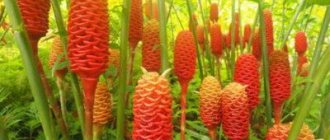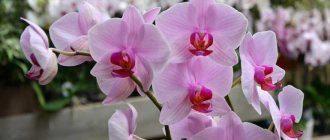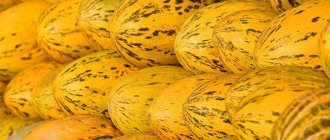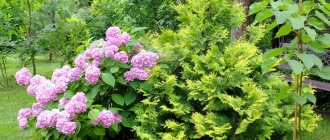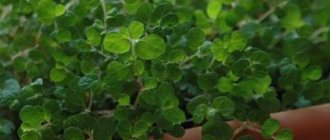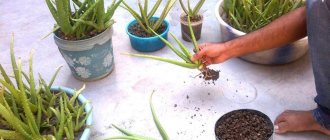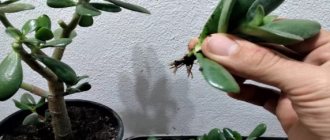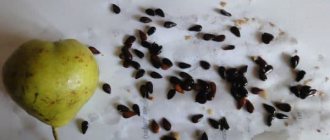The popularity of this spicy root has increased incredibly recently. Ginger is an excellent seasoning for any dish (even desserts); for people with large body weight, it is suitable as a dietary supplement that speeds up metabolism.
Ginger tea is the first aid for colds and nasal congestion.
This is a very interesting indoor plant that disinfects the air and simply looks great, which is easy to see by looking at the photo of this plant.
Features of growing ginger at home
Ginger root is indispensable in the kitchen and in folk medicine. It adds a piquant taste to homemade dishes, strengthens the immune system, promotes the proper functioning of the stomach and liver, and is used to maintain beauty.
This tropical plant looks like a reed (or sedge).
Ginger inflorescences look exotic, and root tubers are often grown for decorative purposes. Many connoisseurs of this exotic plant would like to have it on their windowsills or gardens. For those who love ginger, growing it at home is a convenient way to always have it on hand.
Ways to grow ginger at home
At home, ginger is propagated only by dividing the rhizome. Finding planting material on sale to grow ginger from seeds is almost impossible. However, it is quite possible to cultivate this exotic plant both in the garden and in a pot at home. It is interesting that in its homeland (India), ginger is practically not found growing wild, but businesses based on cultivation and sale are developing everywhere.
The dried root can be kept in warm water for several hours to awaken the buds.
Creating the necessary conditions
Growing ginger in an apartment is possible only if certain conditions are created. It is not enough to simply plant a root; it needs a certain temperature, lighting and humidity to develop successfully.
Temperature
To grow ginger at home on a windowsill, you will need a temperature of at least +23°C.
When it drops to +15°C, the plant stops growing and enters a dormant period. In summer, containers with plants are taken out onto the balcony. The coolness of the night and plenty of fresh air will benefit them.
Air humidity
Like all natives of the tropics, ginger needs high air humidity.
Therefore, it is regularly sprayed with warm, pre-settled water. To increase air humidity, you can also place small containers of water next to the pot.
Lighting
For successful development, ginger requires a large amount of bright light. The length of daylight hours is also important. When grown in winter, it should be at least 12 hours.
To ensure the required level of illumination, additional lighting is provided for ginger. Regular fluorescent fluorescent lamps are quite suitable for this. Now there are special phytolamps on sale. Their range is maximally adapted for growing plants. This allows you to achieve excellent results even with minimal natural light.
Is it possible to grow ginger at home?
Ginger can be grown at home from regular store-bought root. By choosing the right container and choosing the optimal time for planting, you can get a fresh harvest of medicinal-spicy root. The main thing to remember is that ginger is a heat-loving crop with a long growing season, so we need to help it so that the plant has time to ripen during our short summer.
Ginger loves moisture and high air temperatures.
Of course, you can buy ginger root or powder in the store. But then you cannot be sure of its environmental cleanliness. Growing root tubers at home will allow you to personally choose the soil and fertilizing, control the entire process, thereby guaranteeing safety for consumption.
Growing ginger from the root at home requires recreating a microclimate close to the climatic zone where the root tuber grows - the countries of West Africa, Jamaica, Barbados or southern Asia. However, it is not difficult and growing ginger in open ground or in a pot is accessible to everyone.
Note! In a temperate climate, due to lower temperatures, the size of an adult plant and its root will be smaller than in the tropics, but this will not affect the taste.
How to care
Ginger needs to be cared for regularly. In order for the plant to grow strong and healthy, growth conditions must be close to natural. In addition to watering, the plant needs to be fed and the crown trimmed. Pruning is necessary if ginger is grown for its healing roots.
How often to water?
The soil in the pot should be constantly moist, but the plant should not be flooded; water should not stagnate in the pan. Ginger, planted in the spring, reaches the active growth stage in the summer. During this period, the soil should not be allowed to dry out.
Fallen leaves will be a signal of a lack of water. If there is too much water, the roots will begin to rot and the leaves will turn yellow. For irrigation, settled water at room temperature is used. After watering, the soil should be loosened.
What to feed?
After the first shoots appear, ginger grown at home requires feeding every 12-14 days. As an additional source of nutrients for young tropical crops, a mullein mixture or mineral fertilizers are used.
Starting from the end of summer (mid-August) until the end of autumn, the soil is fed with potassium and organic fertilizers, which are applied to the soil of the pot one by one. Nitrogen improves foliage growth, potassium helps in the process of bud formation, phosphorus has a positive effect on the growth of the root system.
Problems, diseases and pests
The tropical crop has natural resistance to diseases and pests. When breeding at home, plant diseases can be encountered due to improper care. The most common problems are:
- Yellowing leaves. The condition occurs due to excessive watering or exposure to direct sunlight.
- Gradual wilting and drying of leaves. Happens due to insufficient watering and spraying.
To correct the situation, it is necessary to identify the causes and adjust care procedures.
If ginger is grown in dry soil, it can become infested with spider mites. Infection is indicated by pale shoots and yellow spots on the leaves that become larger and fill the leaf surface. If you do not fight the pest, the mite will draw all the juices out of the plant. Insects are controlled using the following methods:
- Insecticide treatment. This is carried out until the pest disappears completely.
- Regular watering and spraying. The above-ground part is washed with water, while the roots are covered with a film or bag. After water treatments, the crown should be covered with film to create a moist, warm environment in which mites die. This method has a drawback: eggs laid by mites cannot be destroyed by treatment.
Germination and harvest dates
You can dig up ginger roots in late autumn, when the stem and leaves dry out and turn yellow. From the moment of planting to the ripening of the crop, 8-10 months pass. This period is not enough for the growth of large tubers, so you can dig up individual roots if necessary, leaving donor tubers for the next growing.
How to store the harvest?
It is not necessary to store ginger in the refrigerator. Just clean the dug roots from the ground, dry them in the sun and put them in a cardboard box on a kitchen cabinet shelf for storage. It can also be sent to the freezer.
Required conditions for growing ginger plant
Few people know how to grow ginger at home. In nature, it grows in the tropics in a humid, hot climate. In order to obtain a plant from a ginger root tuber at home, cultivation must occur in compliance with the following parameters:
- temperature: 15-32 C;
- high humidity;
- good lighting;
- bright but diffused light;
- soil acidity 6 pH.
A healthy, fresh root tuber produces buds in a warm and bright place. To stimulate bud growth, the root can be placed in warm water for 2-4 hours before planting. It is unacceptable to heat it in the oven, even at low temperatures, as this dries out the root.
Note! To grow ginger at home, you can take the whole root tuber or its parts. The separated pieces should have active buds, and the cut areas should be coated with an antifungal agent or potassium permanganate.
This is what planting ginger in open ground looks like.
Both in the home garden and in a pot, the root tuber or part of it is placed in the soil with the buds facing up. Below, using an example, we will look at how to plant ginger root at home.
Further agricultural technology
Since ginger root is a tropical crop, it will need certain conditions.
Watering
During the first 7-10 days after rooting in the garden, the crop will need regular watering. The soil on the site should be moist, but stagnation of moisture in the soil should be avoided. The first shoots, under optimal conditions, will appear after 10-14 days. During this period, the regularity of moisture introduction can be gradually reduced. In addition to watering at the root, you will need to spray the above-ground part of the ginger, especially in hot weather. To avoid the risk of sunburn, spraying is carried out only in the evening or morning hours.
Related article:
How to make beds from boards on the site
Loosening
To improve soil aeration, it is recommended to carry out regular loosening. Such activities should be carried out simultaneously with watering, going 1-1.5 cm into the ground with a tool. Such work is carried out throughout the entire growing season.
Fertilizer
After rooting for a month, no additional fertilizing is needed in the ground. After 3-4 weeks, ginger will need microelements, which will need to be applied at the root every one and a half to two weeks. For these purposes, it is worth using mullein infusion. To prepare it, 10 liters of water and 1 kg of organic matter are used, the composition is infused for 24 hours, after which it is used to water the beds.
Starting from August, it is recommended to alternate organic matter with mineral complexes. The emphasis should be on potassium supplements, which have a positive effect on the formation of tubers.
Related article:
5 reasons to sow mustard in a potato field
During the flowering phase, plants will need phosphorus supplements.
How to grow ginger from root tubers?
How to grow ginger at home from root tubers? Germination occurs not from seeds, but from roots. Criteria for a healthy root tuber:
- it must be fresh and have a smooth, glossy skin;
- have buds similar to potato eyes.
The root is planted in April. After half a month, a shoot appears that grows into stems 70-100 cm high with narrow, hard leaves. The success of cultivation depends on maintaining the necessary conditions.
When is the best time to plant ginger at home?
Most often in Russia, ginger, even in the south, is grown as an indoor annual ornamental and medicinal plant. Rhizomes can be planted indoors at any time of the year, but cuttings planted in winter are more practical and produce better results. The optimal time for planting ginger root is the end of winter - the beginning of spring. This way you can get the strongest shoots.
When growing indoors, the size of containers and other containers prepared for plants is of great importance.
How to protect ginger from diseases and pests
To grow ginger in the garden or indoors, you need to know how to protect it from pathogenic bacteria and pests. In most cases, the shrub has increased resistance to microorganisms and parasites. But sometimes it is affected by spider mites.
Pest Control – Spider Mites
The best method to combat it is spraying with chemical insecticides. In this case, eating the roots of the plant is undesirable. Therefore, as a preventative measure, the bush should be given a hot shower every 14 days. The water should be +400C. Additionally, the foliage is washed with soapy water.
HELPFUL ADVICE!
To prevent the pest from settling on the plant, the condition of the leaf blades should be monitored. If detected mechanically (manually), eliminate the representatives. Otherwise, you may lose the plant completely.
What pot and soil is suitable for planting ginger at home?
If you decide to grow ginger on a windowsill, then you should first decide on the purpose, since the choice of pot size depends on it.
Having set yourself the task of harvesting, you should select wider and smaller pots and containers for the plant, which are guaranteed to have enough space for the newly formed roots.
If the purpose of planting ginger is to obtain beautiful flowers and just decoration, it is better to purchase tall and narrow containers. This limits the development of a powerful root system and stimulates the growth of the above-ground part of the flower.
To grow ginger root at home, select a large container.
Simply pouring solid soil into a pot will not be the best solution, so they combine different substances:
- a layer of drainage is placed at the bottom, and holes are also made to drain excess water (2 cm or more);
- Before placing it in a pot, the soil is spilled with a solution of “Fitosporin” to protect against diseases. The soil is perfect for planting vegetables, the main thing is that it is loose and has a neutral pH balance;
- If you do not have the opportunity to purchase high-quality soil at a garden store, you can prepare it yourself from humus or vermicompost, sand and deciduous soil. The prepared components are mixed in equal quantities and the containers are filled.
How and when to harvest ginger?
Harvest in the fall, 9-10 months after planting. A sign of the readiness of root crops is yellowing and dying of shoots. At the same time, rhizomes can be dug up for food within six months after planting.
2 days before harvesting, the crop is no longer watered. Dig up the root crops with a shovel, clear the soil, remove additional roots and dry them. Before drying, the roots can be washed with cold water.
Preparation of planting material
Growing ginger from root at home involves not only preparing the soil, but also choosing the optimal planting material. To do this, we do not go to the garden store, but to the nearest supermarket, where you can find good ginger root.
It is unlikely that you will be able to determine the type of plant by eye in the store, so you will have to buy at random. In fact, varieties differ in the type of inflorescences, but the taste of the root part has a very slight effect.
Note! It is best to take a root with a light, thin skin, smooth and elastic, on which there are at least 2-3 buds (eyes), from which sprouts will then sprout. The bigger, the better.
Do not take dried or frozen roots - such specimens will not sprout.
Soaking ginger root before planting
After purchase, you need to soak the rhizome to remove the substances that are treated in the store to slow down wilting. Usually the root is cut into pieces so that each has at least one bud. The root is left in water for two days (the water must be warm!), but after the first days it is best to add a few crystals of potassium permanganate (1 g per liter of water) or soda (in the proportion of 1 tsp per glass of water). This simple action will disinfect the material and reduce the risk of developing diseases.
After 15-20 minutes, the pieces are taken out, slightly dried, and the sections are sprinkled with ash or crushed coal.
To awaken the kidneys, ginger is soaked in water.
How to properly plant ginger at home?
So, the planting material and soil are prepared - all that remains is to put it together. But how to plant ginger root so that it is guaranteed to germinate?
Pieces of soaked root are placed in a pot with prepared soil so that the buds are at the top. Then they are carefully pressed into the ground, so that the growth areas of future shoots remain above the ground. There is no need to sprinkle on top, but it is better to pour warm water over it. If the air in the room is dry, cover the pot with a bag or film. Thus, after 2 weeks, in conditions of dim light and heat, the first sharp shoots will hatch.
At home, ginger blooms with beautiful spike-shaped inflorescences, usually pink or pink-red, and the height can reach 1 m, but at home the appearance is practically no different. The leaves are smooth and leathery.
Depending on the cultivated variety, ginger flowers may vary in color.
Planting Ginger Root Tubers: A Step-by-Step Guide
After the buds on the root tuber wake up and swell, it is planted in the ground. Step by step it looks like this:
- Large rhizomes are divided into parts. Each of the shoots must have at least one large, viable bud.
- The resulting sections are sprinkled with charcoal powder and allowed to dry.
- The cuttings are planted to a depth of no more than 1-2 cm. They are simply laid out on the surface and then sprinkled with a thin layer of soil.
The first shoots will appear no earlier than in 2 weeks. As soon as they grow to a height of several centimeters, they begin to apply fertilizer.
Ginger root care at home
Since we grow ginger at home, caring for it will not be as painstaking as caring for a plant in open ground.
After planting, the container with the roots can be covered with film to control humidity and maintain it in optimal condition. Place the pot in a warm place with a temperature of approx. 20 °C and above. After 2-3 weeks, the sprouts will break through to the surface.
As soon as the sprouts appear, find a bright place for the ginger. It should not be cold on the windowsill (especially in winter and spring), otherwise the root will rot. In winter, windows facing south are suitable, but in spring and summer, ginger can burn on such windows; it does not tolerate direct sunlight. Ginger does well on east and west windows. In the sun, the plant needs to be shaded.
When the sprouts have already become stronger, the root can be covered with earth so that it does not rise to the surface. Ginger loves moist soil, but does not tolerate stagnant water at all, and can quickly rot.
Water the ginger with settled water at room temperature as the top layer dries. There will also be spraying from a spray bottle. Remember to maintain high humidity, otherwise the plant will wither and die.
Planting a plant
For planting you need 1 part of the plant root. The place where the cut was made must be coated with charcoal. The root is planted vertically in a hole about 20 mm deep. Then water the plant. Cover the pot with film.
Growing ginger. The illustration for the article is used under the standard license ofazende.ru
When sprouts appear, the film must be removed from the container. The pot with the plant must be placed in a warm room with good lighting (with diffused light). It is unacceptable for the plant to be exposed to direct sunlight. Ginger should not be left dry while it is growing. He loves to be watered regularly.
6 months later the plant begins to wilt and the leaves turn yellow. During this period, foliage should be sprayed. Watering needs to be reduced. It is recommended to irrigate little and rarely. The leaves will turn yellow and fall off. This is a sign of the beginning of the harvest.
The plant is dug up, excess soil and unformed roots are removed. Ginger should be dried in the oven at minimum temperature. If the weather is nice and sunny outside, you can dry the ginger in the sun. This process will take 3-4 days.
For the next harvest, you can use your own raw materials. You need to find the narrowest place on the root and cut off several slices from it. The plane on which the cut was made is sprinkled with wood ash. Next it needs to be dried. This will prevent rotting. A plug will be formed that will protect the material before planting in the ground.
The product should be stored in a cellar or basement. The main condition for quality storage is good ventilation and temperature, not lower than +2...+4°C. If there are no such premises, a refrigerator will do. In the case of a large harvest, this storage space is not worth considering.
Selection and timing of fertilizing
The development of ginger should be supported with fertilizers. They are usually applied every 2-3 weeks, and the mineral content is adjusted depending on the desired result:
- nitrogen stimulates the growth and development of leaves;
- potassium fertilizers affect the formation of buds and flowers;
- phosphorus promotes the growth of rhizomes.
Note! For feeding, it is better to use homemade organic fertilizers (since the root is planned to be eaten)
By the end of summer, about a month before the foliage of the flower withers, watering begins to be gradually reduced, and fertilizing is removed completely. This is necessary for a powerful rhizome to begin to form.
Lighting temperature and humidity
As already mentioned above, the ginger flower does not really like direct sunlight (there is a risk of burns on the leaves). But a slightly shaded place or with diffused lighting is perfect for him.
Here we again remember the plant’s home climate - warm and humid. In a dry room, spray and water the ginger more often. It is advisable to maintain the temperature at least +15°C, but not more than +20°C. While waiting for germination, the temperature can reach +22°C, and during the active growth phase - +25°C.
Is it possible to get a harvest?
It is extremely difficult to find this plant in the wild in our latitudes. As you know, the birthplace of ginger is India, and therefore it requires special climatic conditions. Heat-loving ginger does not tolerate drafts, dampness and excessive moisture . He won't like the scorching sun either.
However, the lack of suitable climatic conditions is not at all a reason to refuse to grow ginger. With proper care, it grows both in the garden and on the windowsill. To do this, you only need to follow the rules for caring for the plant, which every Russian gardener can handle. It is grown in conditions of high temperature and humidity, in partial shade, away from drafts and direct sunlight.
For your information. Ginger grown in central Russia will differ from its southern counterparts. But it is possible to obtain roots that are quite suitable for consumption.
Pruning and loosening the soil
In industrial cultivation, ginger is not allowed to bloom in order to obtain a better root harvest. So in our case, if you are not focused on decorating the windowsill, but want to get only a food product, then already at the bud stage, without waiting for the ginger to start flowering, trim these parts. Thus, more effort will be spent on the development of the underground part.
In the summer, when the threat of return frosts has passed, it is better to take the pot out onto the balcony.
The best results will be shown by planting in a greenhouse. If possible, to get a good harvest, it is better to transplant the sprouted ginger root into protected soil (around May). At home, the harvest of root ginger will always be modest. Root growth will be no more than 200%.
Ginger cultivation: varieties of ginger, methods of growing ginger: (read more)
